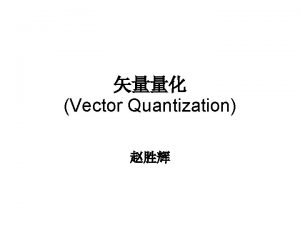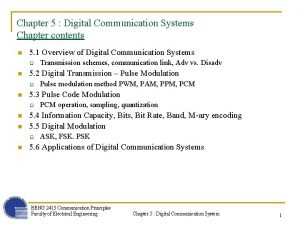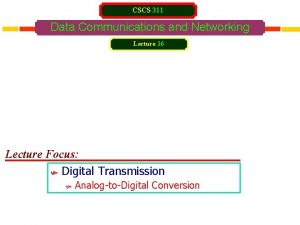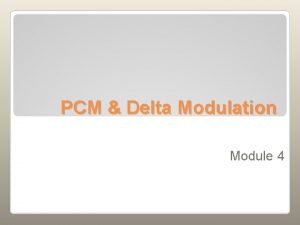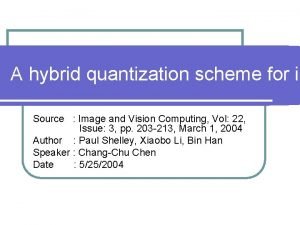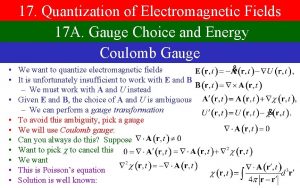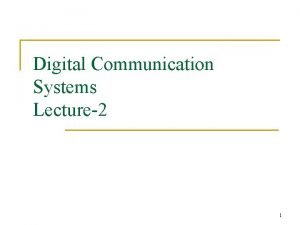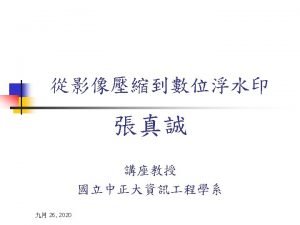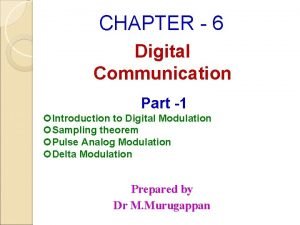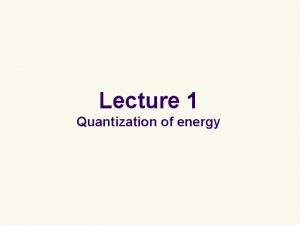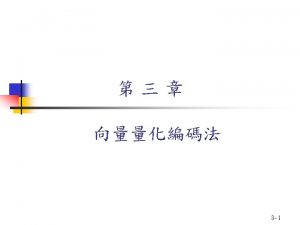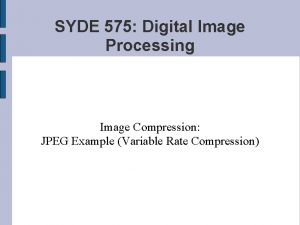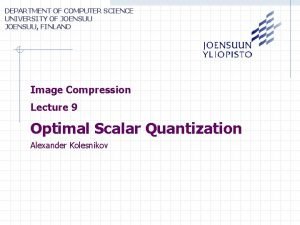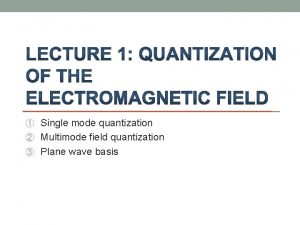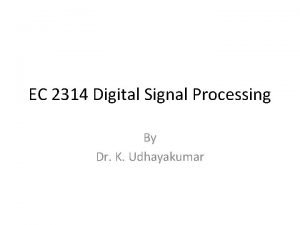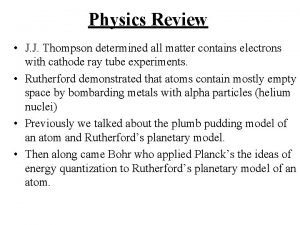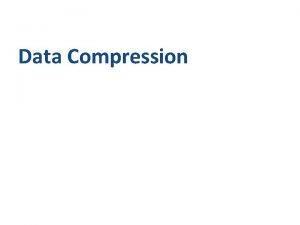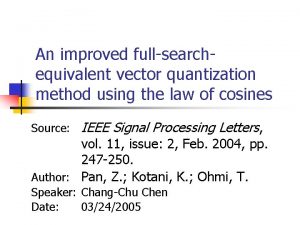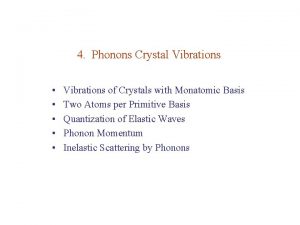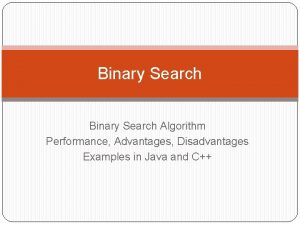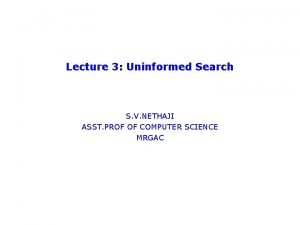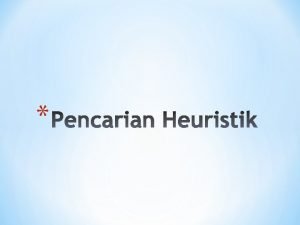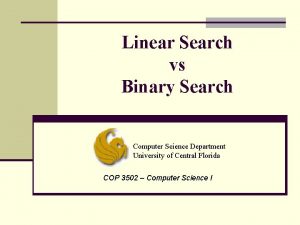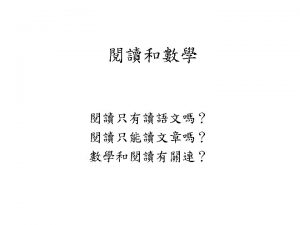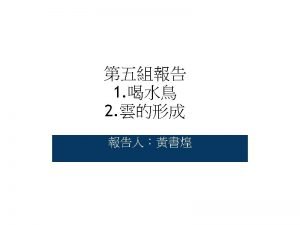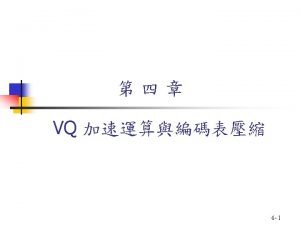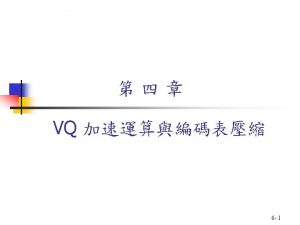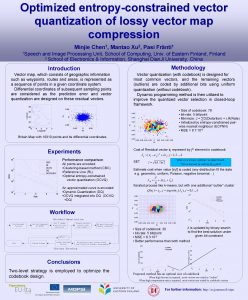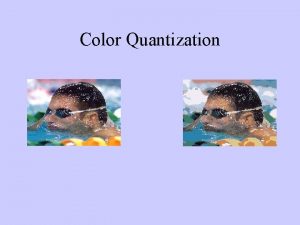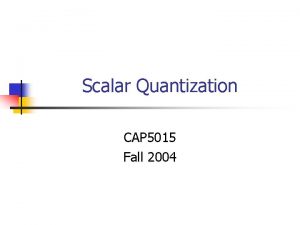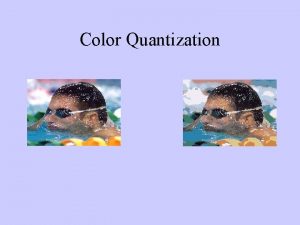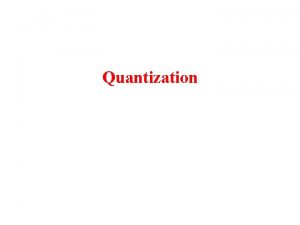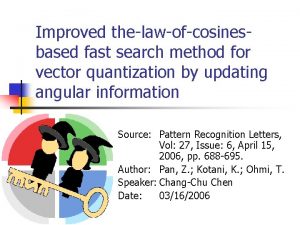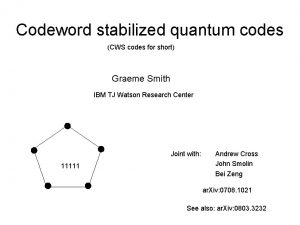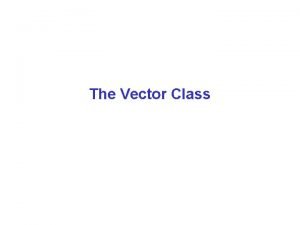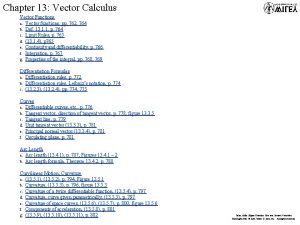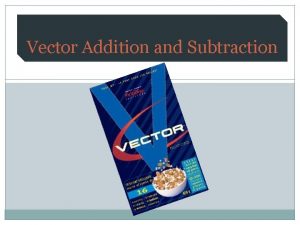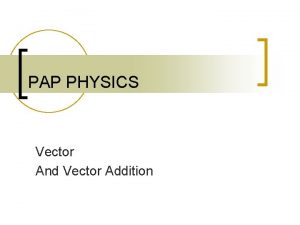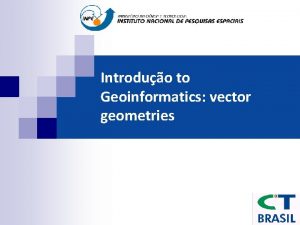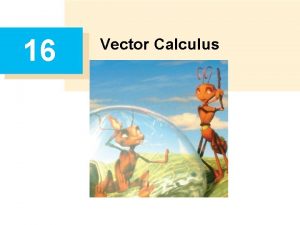4 1 VQ Codeword Search 2 Vector Quantization






![Principal component analysis (PCA) n n D 1 = [0. 710 0. 703] D Principal component analysis (PCA) n n D 1 = [0. 710 0. 703] D](https://slidetodoc.com/presentation_image_h2/448e2b6f9a3fc4c882662e357a5a1551/image-7.jpg)




![The Encoding Algorithm Using PCA Technique n (B) The Encoding Algorithm] n n For The Encoding Algorithm Using PCA Technique n (B) The Encoding Algorithm] n n For](https://slidetodoc.com/presentation_image_h2/448e2b6f9a3fc4c882662e357a5a1551/image-12.jpg)







![Look-up Table (LUT) The content of each pixel belongs to [0, m-1] 20 Look-up Table (LUT) The content of each pixel belongs to [0, m-1] 20](https://slidetodoc.com/presentation_image_h2/448e2b6f9a3fc4c882662e357a5a1551/image-20.jpg)






















- Slides: 42


4. 1 VQ Codeword Search 2

Vector Quantization (VQ) 3

Euclidean Distance n n The dimensionality of vector = k (= w*h) An input vector x = (x 1, x 2, …, xk) A codeword yi = (yi 1, yi 2, …, yik) The Euclidean distance between x and yi 4

4. 2 PCA 5

Principal component analysis (PCA) Given a set of points Y 1, Y 2, …, and YM where every Yi is characterized by a set of variables X 1, X 2, …, and XN. We want to find a direction D = (d 1, d 2, …, d. N), where variance of points projected onto D is maximized. such that the 6
![Principal component analysis PCA n n D 1 0 710 0 703 D Principal component analysis (PCA) n n D 1 = [0. 710 0. 703] D](https://slidetodoc.com/presentation_image_h2/448e2b6f9a3fc4c882662e357a5a1551/image-7.jpg)
Principal component analysis (PCA) n n D 1 = [0. 710 0. 703] D 2 = [-0. 703 0. 710] 7

PCA n n 40 samples with 2 variables, X 1 and X 2 Covariance matrix λ 1 =1160. 139 λ 2 =36. 780 8

Principal component analysis (PCA) λ =1160. 139 n 1 λ =36. 780 n 2 n D 1 = (0. 710, 0. 703) n D 2 = (-0. 703, 0. 710) 9

Principal component analysis (PCA) n Algorithm of PCA n Start by coding the variables Y = (Y 1, Y 2, …YN) to have zero means and unit variances. n Calculate the covariance matrix C of the samples. n Find the eigenvalues λ 1, λ 2, …, λN, for C, where λi λi+1, i = 1, 2, …, N-1. Let D 1, D 2, … DN denote the corresponding eigenvectors. n D 1 is the first principal component direction, D 2 is the second principal component direction, … , DN is the Nth principal component direction. 10

The Encoding Algorithm Using PCA Technique n (A) the codebook processing: n n For each codeword cwi in codebook matrix B, evaluate projected value pi by pi=D 1. cwi. Then, all the codewords in the matrix B are transformed into 256 real numbers. The set of these real numbers can be expressed as P = {p 1, p 2, …, p 256}. Sort the values in P. We obtain the new ordered set P’ = {p’ 1, p’ 2, …, p’ 256} and their corresponding vector cw’ 1, cw’ 2 , … cw’ 256 form an ordered codebook B’={cw’ 1, cw’ 2 , … cw’ 256}. 11
![The Encoding Algorithm Using PCA Technique n B The Encoding Algorithm n n For The Encoding Algorithm Using PCA Technique n (B) The Encoding Algorithm] n n For](https://slidetodoc.com/presentation_image_h2/448e2b6f9a3fc4c882662e357a5a1551/image-12.jpg)
The Encoding Algorithm Using PCA Technique n (B) The Encoding Algorithm] n n For the input vector x, evaluate the projected value px by px = D 1. x. Search the set P’ for r values P’i’s which are the r closest ones to Px. Compute their distances from the set {cw’k, cw’k+1 , … cw’k+r-1} to find a vector cw’j such that (cw’j, x) has a minimum distortion. Here, let the searching range be r and assume that the corresponding codeword of P’j is cw’j. Store or transmit the index j of cw’j 12

The Encoding algorithm using PCA Codebook The covariance matrix 13

The Encoding algorithm using PCA n From the covariance matrix, we compute D 1: (0. 5038, 0. 4904, 0. 4788, 0. 5259), λ 1=19552, D 2: (-0. 4915, -0. 5126, 0. 4293, 0. 5580), λ 2=151, D 3: (-0. 0294, -0. 0292, 0. 7658, -0. 6418), λ 3=86 and D 4: (0. 7098, -0. 7042, -0. 0108, -0. 0134), λ 4=6. D 1: (0. 5038, 0. 4904, 0. 4788, 0. 5259) is a coordinate D 1 reserves 98. 77% information of the variance of the codewords. 14

The Encoding algorithm using PCA The new sorted codebook and the corresponding projected value of codewords Codebook The sorted codewords The projected values D 1: (0. 5038, 0. 4904, 0. 4788, 0. 5259) 15

n n Encode an input vector v = (150, 145, 121, 130) Transform v to ρ= D 1. v =(0. 5038, 0. 4904, 0. 4788, 0. 5259)*(150, 145, 121, 130) T=272 n To search and find that 321. 93 is the closest value to 272 n For 321. 93, d(v, cw’ 5)=63. 2 For 162. 60, d(v, cw’ 4)=122. 3 For 382. 84, d(v, cw’ 6)=114. 2 n So, we choose cw’ 5 to replace the input vector vi. 16

Experimental results n n n The quality of the encoded image is evaluated by the peak signal-to noise ration PSNR, which is defined as For an m*m image, the mean-square error (MSE) is defined as Where xij and denote the original and quantized gray level, respectively. 17

18

![Lookup Table LUT The content of each pixel belongs to 0 m1 20 Look-up Table (LUT) The content of each pixel belongs to [0, m-1] 20](https://slidetodoc.com/presentation_image_h2/448e2b6f9a3fc4c882662e357a5a1551/image-20.jpg)
Look-up Table (LUT) The content of each pixel belongs to [0, m-1] 20

4. 3. 1 Truncated Look-up Table (TLUT) 21

Truncated Look-up Table (TLUT) 0 1 2 … 22

Truncated Look-up Table (TLUT) n For example, r = 256/32 = 8 (17 -34)2= 289 • Error = |289 – 576| = 287 23

4. 3. 2 Reduced Code LUT (RCLUT) n n n Suppose m = 2 l. Express xj (or yij) by Define high nibble H(xj) = the lowest ½ bits of xj= n 24

Reduced Code LUT (RCLUT) 25

Reduced Code LUT (RCLUT) n n H(xj), H(yij), L(xj), L(yij) are within the range [0. 21/2 -1] Look-up Table (LUT) 26

27

Experimental Results 28


An example for indices of VQ 30

4. 4. 1 Search-Order Coding (SOC) 31

4. 4. 2. Locally Adaptive scheme An example of segmentation with region size 4*4 for indices of VQ 32

The block diagram of the proposed scheme 33

The compressing steps of our example 0 10 10 31 207 211 31 207 8 207 31 211 8 7 35 31 8 7 01 10 11 11 100 011 34

The decoding steps of our example 31 207 211 31 207 8 207 31 211 8 7 35 31 8 7 0 10 10 01 10 11 11 100 011 35

Experimental results 36

The comparison of two schemes in the unmatched index numbers 37

The comparison of three schemes in compression results 38

The comparison of proposed method and SOC scheme in bit rate (bit/pixel) 39

Discussions 40

Discussion of the VQ scheme n Advantage: n The bit rate of the VQ scheme is low. bit rate = n n bpp. Example: n When the codebook is composed of 256 codewords. Each block used is of 4*4 pixels. n n bit rate = 0. 5 bpp VQ has a simple decoding structure. 41

Discussion of the VQ scheme n Disadvantage: n The reconstructed image quality highly depends on the codebook performance. n Therefore, how to design a representative codebook is an important issue of VQ scheme. n The VQ scheme requires a lot of computation cost in codebook generation process and VQ encoding process. 42
 Vector quantization
Vector quantization Scalar and vector quantization
Scalar and vector quantization Advantages of companding
Advantages of companding Quantization in digital communication
Quantization in digital communication Calculate quantization error
Calculate quantization error Snr formula for delta modulation
Snr formula for delta modulation Xxrrrrr
Xxrrrrr Quantization of electric field
Quantization of electric field Sampling and quantization
Sampling and quantization Quantization error formula
Quantization error formula Quantization
Quantization Quantization definition in digital communication
Quantization definition in digital communication Quantization of energy
Quantization of energy Quantization
Quantization Syde 575
Syde 575 Calculate quantization error
Calculate quantization error Quantization
Quantization The noise that affects pcm
The noise that affects pcm Quantization
Quantization Digital signal processing
Digital signal processing Quantization
Quantization Image compression
Image compression Quantization
Quantization Quantization of charge
Quantization of charge Vibration of crystals with monatomic basis
Vibration of crystals with monatomic basis Vector properties
Vector properties Vector unitario
Vector unitario Why is vector resolution the opposite of vector addition
Why is vector resolution the opposite of vector addition Define the position vector
Define the position vector Advantages and disadvantages of linear search
Advantages and disadvantages of linear search Federated search vs distributed search
Federated search vs distributed search The blind search algorithms are.
The blind search algorithms are. Comparison of uninformed search strategies
Comparison of uninformed search strategies Blind search dan heuristic search
Blind search dan heuristic search Linear search vs binary search
Linear search vs binary search Informed search and uninformed search
Informed search and uninformed search Yahoo shopping tw
Yahoo shopping tw Gravity yahoo
Gravity yahoo Federated discovery
Federated discovery Images.search.yahoo.com
Images.search.yahoo.com Mail @ malaysia.images.search.yahoo.com
Mail @ malaysia.images.search.yahoo.com Searchyahoo
Searchyahoo Local search vs global search
Local search vs global search

